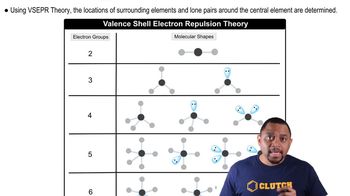The valence electron configurations of several atoms are shown here. How many bonds can each atom make without hybridization? a. B 2s22p1 b. N 2s22p3
 Tro 4th Edition
Tro 4th Edition Ch.10 - Chemical Bonding II: Molecular Shapes & Valence Bond Theory
Ch.10 - Chemical Bonding II: Molecular Shapes & Valence Bond Theory Problem 46a,b
Problem 46a,bDetermine the geometry about each interior atom in each molecule and sketch the molecule. (Skeletal structure is indicated in parentheses.)
a. CH3NH2 (H3CNH2)
b. CH3CO2CH3 (H3CCOOCH3 One O atom attached to 2nd C atom; the other O atom is bonded to the 2nd and 3rd C atom)
 Verified step by step guidance
Verified step by step guidance
Verified Solution
Key Concepts
Molecular Geometry

VSEPR Theory

Skeletal Structure

Using the molecular orbital energy ordering for second-row homonuclear diatomic molecules in which the π2p orbitals lie at lower energy than the σ2p, draw MO energy diagrams and predict the bond order in a molecule or ion with each number of total valence electrons. Will the molecule or ion be diamagnetic or paramagnetic?? b. 6 d. 9
How many types of hybrid orbitals do we use to describe each molecule? a. N2O5 c. BrCN (no formal charges)
Write a hybridization and bonding scheme for each molecule. Sketch the molecule, including overlapping orbitals, and label all bonds using the notation shown in Examples 10.6 and 10.7. c. OF2 d. CO2
Determine the geometry about each interior atom in each molecule and sketch the molecule. (Skeletal structure is indicated in parentheses.) a. CH3OH (H3COH) b. CH3OCH3 (H3COCH3)
Determine whether each molecule is polar or nonpolar. a. SCl2 b. SCl4